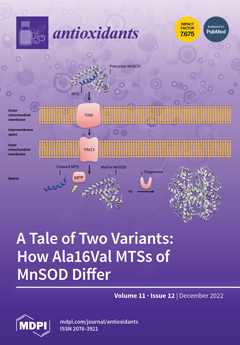The study was designed to analyze and evaluate the antioxidant and antibacterial properties of the essential oils of
Thymus pulegioides L. grown in Western Romania.
Thymus pulegioides L. essential oil (TPEO) was extracted by steam distillation (0.71%
v/w) using a Craveiro-type apparatus.
[...] Read more.
The study was designed to analyze and evaluate the antioxidant and antibacterial properties of the essential oils of
Thymus pulegioides L. grown in Western Romania.
Thymus pulegioides L. essential oil (TPEO) was extracted by steam distillation (0.71%
v/w) using a Craveiro-type apparatus. GC-MS investigation of the TPEO identified 39 different compounds, representing 98.46% of total oil. Findings revealed that thymol (22.89%) is the main compound of TPEO, followed by
para-cymene (14.57%), thymol methyl ether (11.19%), isothymol methyl ether (10.45%), and beta-bisabolene (9.53%). The oil exhibits good antibacterial effects;
C. parapsilosis, C. albicans,
S. pyogenes, and
S. aureus were the most sensitive strains. The antioxidant activity of TPEO was evaluated by peroxide and thiobarbituric acid value, 1,1-diphenyl-2-picrylhydrazyl radical (DPPH), [2,2′-azinobis(3-ethylbenzothiazoline-6-sulfonic acid) diammonium] (ABTS) radical scavenging assay, and beta-carotene/linoleic acid bleaching testing. The antioxidative data recorded reveal, for the first time, that TPEO inhibits primary and secondary oxidation products, in some particular conditions, better than butylated hydroxyanisole (BHA) with significant statistical difference (
p < 0.05). Moreover, TPEO antioxidant capabilities in DPPH and ABTS assays outperformed alpha-tocopherol (
p < 0.001) and delta-tocopherol (
p < 0.001). Molecular docking analysis revealed that one potential target correlated with the TPEO antimicrobial activity was
d-alanine-
d-alanine ligase (DDl). The best scoring ligand, linalyl anthranilate, shared highly similar binding patterns with the DDl native inhibitor. Furthermore, molecular docking analysis also showed that the main constituents of TPEO are good candidates for xanthine oxidase and lipoxygenase inhibition, making the essential oil a valuable source for protein-targeted antioxidant compounds. Consequently, TPEO may represent a new potential source of antioxidant and antibacterial agents with applicability in the food and pharmaceutic industries.
Full article


